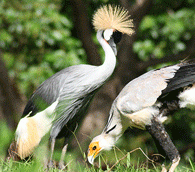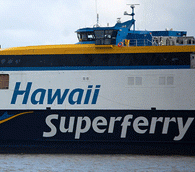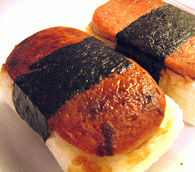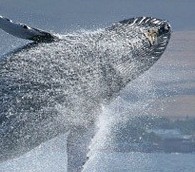Destination: Maui
Island Eats: Mango Smoothies
by Pam Mandel | 03.26.09 | 1:52 PM ET
I’m an extremely addicted coffee drinker, but I have a guilty confession to make: I didn’t find the coffee in Hawaii all that great. That’s why, given the choice between a less-than-satisfying cup of joe and a big orange slurp of calorie-laden deep orange-yellow lusciousness, I went with the mango smoothie every time. I’m sure mangoes are full of things that are way better for me than caffeine salvation, but that’s not why I made the switch during my island time. Nope, it’s because mango smoothies are seductively, amazingly delicious. And at least as revitalizing as a poor-to-middling cup of coffee.
My favorite was, hands down, the one from that guy in the Maunakea Marketplace Food Court in Honolulu’s Chinatown. That fruit stand on the way back from Hana, its weren’t bad either, though I was sure one of those stoner kids was going to lose a finger at best, an entire limb at worst, swinging that machete around while high as a kite on one of Maui’s other abundant crops. I skipped the bicycle-powered blender, also on the Hana Highway because I was having an uncharacteristically un-Hawaiian moment of impatience. But I swerved to a halt at the first fruit stand on the way towards Volcano on the road from Kaleakakua Bay. “Large, please. Mango. Mahalo.”
Hawaii’s Endangered Birds: Wake Up, Already!
by Pam Mandel | 03.23.09 | 11:00 AM ET
I’m as surprised as anyone to find myself turning into a bird watcher—it’s a short walk from where I am to high-waisted cargo pants, a vest full of pockets and a pair of binoculars that will allow me to see well into the next county. (I kid, I kid. Bird watchers come in all shapes, sizes and victims of fashion.) My affection for all things avian is why I was saddened to read the report on Hawaii’s failing bird population.
From the AP
One-third of the nation’s endangered birds are in Hawaii, said the report issued Thursday by the Interior Department. Thirty-one Hawaiian bird species are listed as endangered, more than anywhere else in the country.
Birds are a critical part of any visit to Hawaii—the moment the sun pops over the horizon, the birds go off, alarm clock style, making all kinds of racket until they are sure you are good and awake, settling down to spend their days in a less disruptive way once you’ve given up the earplugs, found a cup of coffee and admitted defeat. Maybe they know you have to be on the pier, pronto, to catch that snorkel boat or whale-watching tour, and they are not going to let you miss it, not if they have anything to say about it.
The Superferry’s Last Sail
by Pam Mandel | 03.20.09 | 10:37 AM ET
From day one, Hawaii’s Superferry was fraught with problems. It’s all over now. On March 19, the Superferry made its final run between Oahu and Maui.
From a logistics point of view, the ferry made travel between Oahu and Maui seem a lot easier. Drive on, drive off, with whale-watching thrown in for the price of the crossing, in season. Tourism boosters loved it, as did parents and schools—it made getting your baseball team to that game on Maui a snap, and you could bring your own bus or squeeze the whole swim team into the minivan.
But Hawaiian traditionalists objected to the Superferry because it made it too easy to plunder, like a pirate in a pickup truck, island resources. Environmentalists worried about the whales. And quality-of-life types bemoaned the traffic, suggesting that the cars lined up on either end would cause not only pollution, but delays and crowds.
The Superferry ran, and then it didn’t, and then it ran, and then it didn’t. If you held a ticket, you had to check the website the day of your sailing and, even then, there was no guarantee that you wouldn’t be turned back by protesters. The case to block the Superferry went all the way to the Hawaii Supreme Court. The issue? The Superferry had been allowed to operate before the environmental impact research was complete.
The Hawaii Supreme Court on Monday ruled that a law allowing the Superferry to operate while conducting an environmental impact statement was unconstitutional.—MSNBC
It’s back to interisland flights for travelers.You can’t take your car, but you’re less likely to get seasick. And yeah, you can get a refund for that Superferry ticket.
Hawaii vs. Office of Hawaiian Affairs
by Pam Mandel | 02.24.09 | 12:48 PM ET
A brief disclaimer: I’m not an expert on legal matters and while I’ve been doing lots of reading, there’s still lots I don’t understand. Because of that, I absolutely welcome your more enlightened comments on the case. I’d just like to get you interested in what’s happening and why it’s a big deal, I’m going to keep it brief and send you elsewhere to more expert commentary. Now, in summary:
The Hawaiian State Supreme Court previously ruled that the state (Hawaii) could not sell lands ceded in the overthrow of the Hawaiian Monarchy until a settlement on those lands had been reached with the Hawaiian people. The gist? The lands were ceded to the U.S. government by those who had no right to do so.
The state of Hawaii is appealing the decision—it wants the right to sell those lands. It says that its ability to manage the lands is impeded by this ruling. That’s the bare bones of the case. But Native Hawaiians see a lot more at stake in the Supreme Court’s first case tomorrow.
Gov. to Hawaii: Tear Down This Clothesline
by Pam Mandel | 02.20.09 | 12:26 PM ET
From the Pacific Business News:
A similar bill, jokingly referred to as the “right to dry bill” passed the Legislature in 2008 but was vetoed by Gov. Linda Lingle.
House Bill 1273, introduced by several environmentally conscientious House representatives, includes language that says a residential board may implement “reasonable restrictions with regard to the placement of the clothesline so long as the restrictions do not prohibit clotheslines altogether.”
Ah, the politics of a tourism-driven economy. I’m going to stick my neck out and guess that the reason the gov vetoed the bill was hefty lobbying about aesthetics from resort developers and tourism boosters. “All that underwear is going to wreck our view!”
Confession: I’ve shot photos in any number of European towns of laundry drying on the line. The Italians seem to do a nice job making laundry aesthetic. I’d be hard pressed not to be giddy at the sight of a line full of Aloha shirts flapping in the Hawaiian breeze.
Iz, Gabby Pahinui and the Sounds of Hawaii
by Pam Mandel | 02.10.09 | 11:36 AM ET
Big Iz’s “Over the Rainbow” is an iconic ukulele track—it’s often the first thing folks ask me to play when they learn I have a uke. If you’ve heard the full track—it slid into U.S. consciousness a few years back via a toy store advertisement—then you’ve heard the bit at the beginning where Iz says, in his perfect, soft voice, “K, this one’s for Gabby.”
Iz is referring to Gabby Pahinui. Even though Gabby died in 1980, he’s credited with being the master of slack key. You can take his title as the father of Hawaiian music more literally, too: three of his sons, Cyril, Martin, and Bla are recording artists. For me, Cyril’s sweet falsetto and the sound of slack key guitar evoke the islands like nothing else. I’ve had the good fortune to see Cyril Pahinui on the mainland and in the islands—he’s often on tour with Led Kaapana, another slack key super genius.
Island Eats: Spam Musubi
by Pam Mandel | 02.04.09 | 11:39 AM ET
Blame WW II. It was the food of soldiers stationed in the islands and somehow, it stuck—cans of the meat-like product making their way past the gates of military bases and into Hawaiian daily life. According to an older article in the Honolulu Star-Bulletin, islanders go through 7 million cans of Spam annually. Spam seems to show up everywhere Hawaiians are found—Hawaiian center fielder for the Phillies Shane Victorino took heat last year from PETA (People for Ethical Treatment of Animals) for admitting that Spam musubi was one of his favorite foods. And stalkerish reporting on every action taken by our new president on his last trip to the islands revealed that he ordered Spam musubi for lunch while on a golf outing.
Paddling Among Giants
by Jim Benning | 05.27.08 | 3:28 PM ET
The planet is heating up. The news can be overwhelming. But on a kayaking trip off Maui, Jim Benning found some big antidotes to pessimism.
- « Prev Page
- Next Page »




